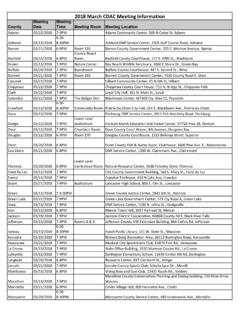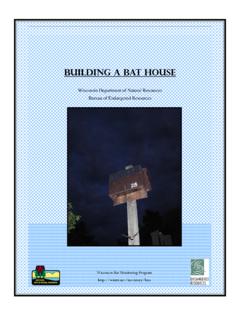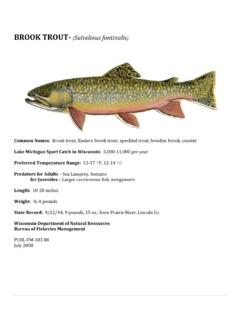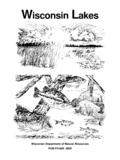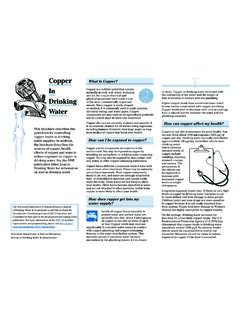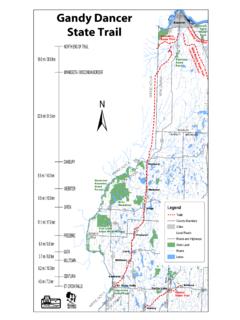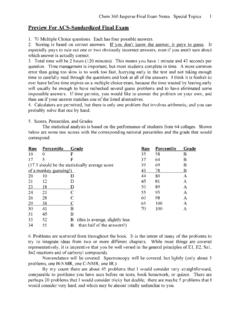Transcription of Basic General Wastewater Study Guide
1 Printed on 01/12/17 Basic General Wastewater Study GuideWisconsin Department of Natural Resources Operator Certification Program PO Box 7921, Madison, WI 53707 2015 Edition (Revised June 2016)Wisconsin Department of Natural ResourcesThe Wisconsin Department of Natural Resources provides equal opportunity in its employment, programs, services, and functions under an Affirmative Action Plan. If you have any questions, please write to Equal Opportunity Office, Department of Interior, Washington, 20240. This publication is available in alternative format (large print, Braille, audio tape. etc.)
2 Upon request. Please call (608) 266-0531 for more Operator CertificationPrinted on 01/12/17 PrefaceThe General Wastewater Study Guide is an important resource for preparing for the certification exam and is arranged by chapters and sections. Each section consists of key knowledges of important informational concepts you need to know for the certification exam. This Study Guide also serves as a Wastewater treatment plant operations primer that can be used as a reference onthe subject. In preparing for the exams: 1. Study the material! Read every key knowledge until the concept is fully understood and committed to memory.
3 2. Learn with others! Take classes in this type of Wastewater operations to improve your understanding and knowledge of the subject. 3. Learn even more! For an even greater understanding and knowledge of the subjects, read and review the references listed at the end of the Study Guide . Knowledge of the Study Guide material will be tested using a multiple choice format. Every test question and answer comes directly from one of the key knowledges. Choosing a test date: Before choosing a test date, consider the time you have to thoroughly Study the guides and the training opportunities available.
4 A listing of Wastewater training opportunities and exam dates is available at by searching for the keywords Operator Certification .AcknowledgementsThe General Wastewater Study Guide was the result of a collaborative effort of yearlong monthly meetings of Wastewater operators, trainers, consultants, the Wisconsin Wastewater Operator Association (WWOA) and the Wisconsin Department of Natural Resources (WDNR). This Study Guide was developed as the result of the knowledge and collective work of following workgroup members: Kurt Birkett, Fort Atkinson WWTP, Fort Atkinson, WI Gary Hanson, AECom, Sheboygan, WI Greg Paul, QLF Specialty Products, Dodgeville, WI Dan Tomaro, Wastewater Training Solutions, Oregon, WI Mark Corbett, Department of Natural Resources, Oshkosh, WI Amy Garbe, Department of Natural Resources, Madison, WI Danielle Luke, Department of Natural Resources, Madison, WI Jack Saltes, Department of Natural Resources, Madison, WIBasic General Wastewater Study Guide - August 2015 Edition (Revised June 2016)
5 Printed on 01/12/17 Chapter 1 - TerminologyChapter 2 - Influent WastewaterChapter 3 - Wastewater TreatmentChapter 4 - Biosolids/Sludge - Processing, Handling, and Land ApplicationChapter 5 - Effluent DischargeChapter 6 - Safety and RegulationsSection - Flows and PollutantsSection - Sewer SystemsSection - Wastewater ProcessesSection - Safety and RegulationsSection - SourcesSection - ConveyanceSection - Wastewater CharacterisiticsSection - Flow MonitoringSection - SamplingSection - Preliminary TreatmentSection - Primary TreatmentSection - Secondary (Biological) TreatmentSection - final ClarificationSection - Tertiary TreatmentSection - DisinfectionSection - Ponds and LagoonsSection - EquipmentSection - Treatment Plant and Equipment MaintenanceSection - ThickeningSection - TreatmentSection - DewateringSection - Land ApplicationSection - Sampling and ReportingSection - Flow MonitoringSection - SamplingSection - Permitting and ReportingSection - Personal SafetySection - Chemical SafetySection - Management of Wastewater Treatment PlantsTable of ContentsBasic General Wastewater Study Guide - August 2015 Edition (Revised)
6 June 2016)pg. 1pg. 2pg. 3pg. 5pg. 6pg. 8pg. 10pg. 13pg. 15pg. 17pg. 21pg. 24pg. 30pg. 32pg. 33pg. 35pg. 37pg. 50pg. 54pg. 56pg. 58pg. 61pg. 62pg. 63pg. 64pg. 66pg. 69pg. 70pg. 70 Printed on 01/12/17 Chapter 7 - CalculationsSection - SamplingSection - Flow Conversions and Flow RateSection - Tank Areas and VolumesSection - Pounds FormulaSection - Pump RateSection - Detention TimeSection - Percent RemovalTable of ContentsBasic General Wastewater Study Guide - August 2015 Edition (Revised June 2016)pg. 70pg. 71pg. 72pg. 73pg. 74pg. 76pg. 77 Printed on 01/12/17 Page 1 of 79 Chapter 1 - TerminologySection - Flows and PollutantsBOD, expressed in mg/L, is a measurement of the organic strength of a sample by measuring the amount of oxygen consumed over a given period of composite sample is a sample prepared by combining a number of grab samples.
7 Typically over a 24-hour is the measure of the amount of oxygen dissolved in water and is expressed in is the treated Wastewater discharged from a treatment plant to the is the excessive growth of plant and algae in receiving waters due to dissolved nutrients and their flume is a restriction in an open channel used to measure is the amount of food (BOD) provided to the microorganisms [mixed liquor volatile suspended solids (MLVSS) or mixed liquor suspended solids (MLSS)].The term gpd is a common Wastewater flow measurement expressed as the number of gallons flowing each term gph is a common Wastewater flow measurement expressed as the number of gallons flowing each term gpm is a common Wastewater flow measurement expressed as the number of gallons flowing each grab sample is a single sample taken at a particular time and place that is representative of the current biochemical oxygen demand (BOD).
8 Define composite dissolved oxygen (DO).Define food to microorganism ratio (F:M or F/M).Define gallons per day (gpd).Define gallons per hour (gph).Define gallons per minute (gpm).Define grab hydraulic retention time (HRT). Basic General Wastewater Study Guide - August 2015 Edition (Revised June 2016)Printed on 01/12/17 Page 2 of 79 Section - Sewer SystemsHRT is a period of time that Wastewater remains in a tank. This term is also known as detention is the raw (or untreated) Wastewater entering a treatment measurement mg/L is a concentration of a substance in a liquid expressed as a weight in milligrams per liter of volume (mg/L).
9 Milligrams per liter is the same as parts per million (ppm). 1 mg/L = 1 ppm (One liter of water weighs 1,000,000 mg)MGD is a common Wastewater flow measurement in a treatment plant, expressed as millions of gallons (MG) of Wastewater flowing each is a measure of the acidity or alkalinity of a sample on a scale of 0 to 14 (acidic to alkaline). A pH of 7 is is the high strength waste pumped out of septic tanks, sometimes disposed at Wastewater treatment age is the theoretical length of time a particle of activated sludge stays in the treatment plant, measured in days. In an activated sludge plant, sludge age is the amount (lbs) of MLSS divided by the suspended solids or excess cell mass withdrawn from the system per day [lbs per day of waste activated sludge (WAS)].
10 TSS is the measure of the total amount of solids suspended in a sample and is expressed in weir is a level control structure used to provide uniform sewers are pipe conveyances that carry both Wastewater and storm water in a single pipe. During dry weather conditions, combined sewers discharge to a Wastewater treatment plant. In the past, combined sewers discharged directly to a water body during wet weather conditions. Today, the extra wet weather volume is stored until it can be returned to the Wastewater treatment milligrams per liter (mg/L).Define million gallons per day (MGD).Define sludge total suspended solids (TSS).

